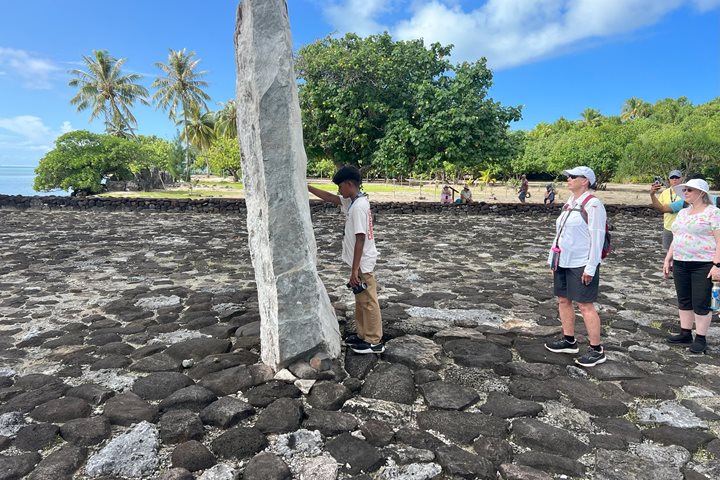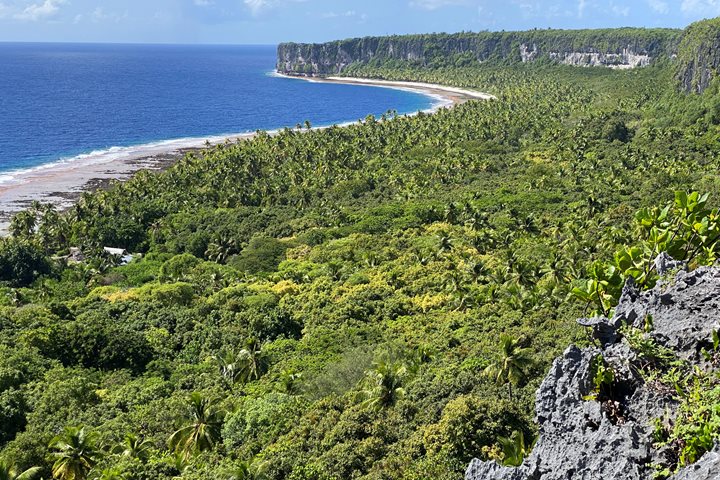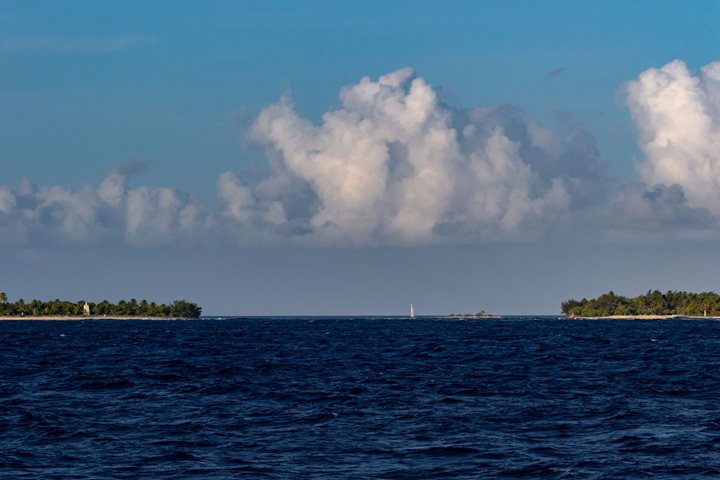The islands of French Polynesia present a wonderful variety of landscapes and scenery, from the steep green volcanic mountains of the Society Islands to the low, flat coral atolls of the Tuamotus. The Gambier Archipelago is located at the southeast region of the Tuamotu Group, which consists of five major archipelagos. Whereas most of the Tuamotus are coral atolls, the Gambiers are the remnants of a single huge volcano. A few fragments of that great mountain still rise above the waves, most notably the central island of Mangareva. A barrier reef, measuring 15 miles across, surrounds Mangareva and has created a blue lagoon that is sprinkled with small coral reefs and is a perfect habitat for pearl farms. There are three navigable entrances, and the northwest pass will allow us to bring our vessel inside the protective reef. The outer reef, home to an enormous variety of fish and corals, is often pounded by surf and drops off very steeply into the deep blue.
Once inside the lagoon, we completed clearance procedures into France, and soon after breakfast we launched our Zodiacs and landed in the main town of Rikitea. Some of us opted to make a long and very challenging hike up to the summit of Mt. Duff, the highest point in the islands, which rises to 1,447 feet above the lagoon. The trail is very steep and very demanding, and reaches the top in only two miles! Of course, the view from the summit is incredible, as we could see the entire archipelago and far out over the sea beyond. Meanwhile, others of us took more time to explore Rikitea and visit the fascinating historic sites of what was once described as a Spanish city.
Mangareva was first occupied by Polynesians that settled the islands in the 10th Century. However, evidence indicates the islands were deforested by AD 1500, which led to disastrous effects on the islands' environment and economy. The trade network broke down and Mangareva became isolated as the outlying trading partners, Pitcairn and Henderson islands, died out.
In 1834, three members of the Order of the Sacred Heart monastery in Valparaiso, Chile, led by Father Louis Honoré Laval, came to Mangareva and began to convert the Polynesians to Christianity. Once King Maputoea converted, Laval gained complete control over the populace, and during the next three decades he oversaw what historians call “the death of a people.” He established a theocratic dictatorship, including ecclesiastical police to enforce a strict moral code, and he exerted control of the trade economy of pearls with the outside world. Laval insisted on locking up the entire female population in the convent whenever whaling ships arrived. The Polynesian marae and statues were destroyed and several Christian chapels were constructed on their sites. After a vision, Father Laval ordered the construction of St. Michael’s Cathedral – the largest church in the South Pacific. All able-bodied persons were put to work on the project. It took nine years to build and when completed it could accommodate 1,200 people. In addition, a palace for the king, a monastery, a convent, a prison, a textile factory, and coastal watchtowers were also constructed. It became a city, the likes of which no Polynesian island had ever seen.
Forced labor, the loss of ancient customs, unaccustomed clothing, and tuberculosis exacerbated from living within stone walls are all believed to have contributed to a devastating depopulation of the Gambier Islands. It has been estimated that the Gambier Islands may have had a population of 9,000 people before the coming of Europeans, but by 1843, only about 1,500 people remained. And within a couple more decades the population declined to only a few hundred. Reports of the terrible loss of life and suffering within the Gambiers eventually reached the provincial government in Papeete, an investigation ensued, and Father Laval (dubbed “the mad priest”) was recalled. His infamous response to the inquiry was “they have but gone more quickly to heaven."
Nevertheless, the resulting cathedral is nothing short of magnificent, especially since its restoration within the past ten years. It is built entirely from quarried blocks of coral. Inside, we marveled at the huge columns and admired the impressive altar, richly decorated with pearls, and pearl shell. About 85% of the roughly 1,500 Mangarevans that live here today are Catholic and they still conduct their services here. We continued walking about the other remaining structures of the city built during Father Laval’s tenure, but the highlight was passing by the school when some of the children were practicing Mangarevan dancing. Our guide pointed out that they do not dance with the provocative hip swinging like other Polynesians, which is probably a leftover effect from the time of Laval’s legacy. Several of us walked up the road to see the ruins of Couvent Rouru, which is said to have housed 60 nuns at one time. We then had some free time to stroll the quiet streets before returning to the ship for lunch.
In the afternoon, we repositioned the ship to Motu Aukena, where we enjoyed several different activities, both in and above the water. We snorkeled between healthy coral gardens with lots of little fish seen among the coral. Some guests also enjoyed kayaking in this beautiful protected area, and others explored the island itself. A group of us explored the island and followed a trail inland through a beautiful mixed forest of hibiscus trees, coconut palms, pandanus trees, and casuarina trees. Along the way, we found the ruins of a boys school as well as a candlenut processing stone structure and one of the watch towers erected around the archipelago to watch for incoming whale ships and trading vessels…all from Father Laval’s time.







